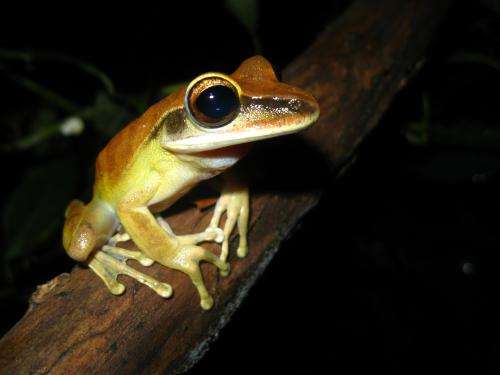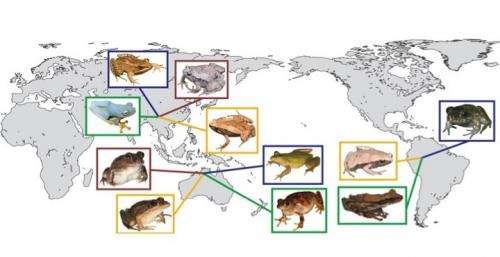No matter the continent, the world's frogs have a lot in common, biologist finds

(Phys.org) —A University of Arizona biologist researching frog evolution has discovered striking similarity in frog species on different continents and proposes two very different ways that this similarity comes about.
In a study published in the journal Proceedings of the Royal Society B: Biological Sciences, ecology and evolutionary biology professor John Wiens and collaborators suggest that the similarity in frog species across continents has two explanations. In some cases, different groups of frogs evolved similar characteristics in parallel on different continents, while in other cases the same group of frogs maintained similar characteristics over huge distances and vast periods of time as they moved between continents.
Wiens worked with collaborators Dan Moen and Duncan Irschick in studying frogs from three different sites on three continents, in China, Colombia and Australia. They quantified how well different frog species performed the same tasks, including jumping, swimming, and clinging to a slick surface. They also measured anatomical traits related to these tasks, like leg length and muscle mass.
"All around the world, any given location is likely to have frogs that either climb trees, burrow, live on the ground or live in water," Wiens says. "One of the things we've found is that frogs that use the same microhabitat tend to be very similar, both in their morphology and in their performance. For example, all around the world, frogs that live in trees usually have expanded pads at the tips of their fingers and toes that help them cling to smooth surfaces. Similarly, frogs that live in water have thick leg muscles and heavily webbed feet that help them swim faster."

Wiens says that in some cases, this similarity in species across continents is explained by groups of species staying the same over time but moving over huge distances.
"In one interesting case, there are species in a group called the narrow-mouthed frogs that are very similar in both South America and China, and this is because they've changed very little over 65 million years and as they've spread around the world," he says. "Another example is a group of tree frogs that originated in South America and have spread to both China and Australia."
This pattern of evolutionary conservatism over time coupled with long-distance dispersal can explain similarity in many different organisms from all around the world, Wiens says. However, the pattern remains relatively poorly studied.
Other groups of frogs have followed a very different path. Instead of staying the same over time and moving, they have evolved to use different microhabitats while staying in the same place.
"The really cool thing we found is what happened in Australia. There all the different habitat types have all evolved from tree frogs. After the tree frogs went from South America to Australia, some stayed in the trees, but others became burrowing, aquatic and terrestrial frogs," Wiens says. "The species of tree frogs that evolved to use these new microhabitats show no trace of their tree frog ancestry, and are basically indistinguishable from unrelated burrowing, terrestrial and aquatic species on other continents."
Journal information: Proceedings of the Royal Society B
Provided by University of Arizona




















